Launching the 25th generation of a cutting-edge global teamwork class at Stanford
The AEC Global Teamwork course brings together students from around the world to produce advanced building projects. The students work remotely, using innovative technologies to collaborate across disciplines, time zones and cultures.
Teamwork across disciplines is an increasingly common concept in the building industry. But Renate Fruchter was years ahead of this trend.
In 1993, Fruchter, a lecturer and senior research engineer in civil and environmental engineering at Stanford University, established the Project Based Learning Laboratory (PBL Lab) to develop and investigate project-based learning – an educational process whereby students gain knowledge and skills through long-term, real-world challenges – with an emphasis on multidisciplinary, remote teamwork.
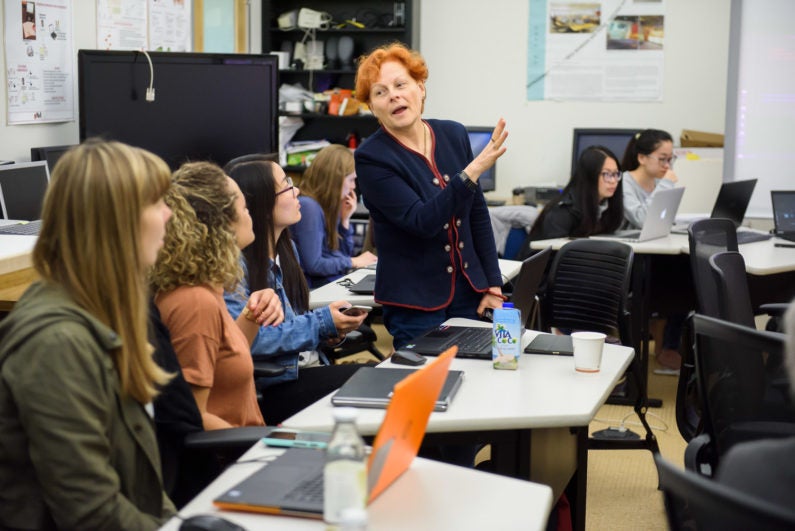
Renate Fruchter, lecturer and senior research engineer in civil and environmental engineering, with the Stanford-based students of 2016-2017 class. Teammates from other locations were also participating in this session over instant messaging, screen sharing and web conferencing. (Image credit: L.A. Cicero)
As part of her lab’s mission, she also created a new course for civil and environmental engineering students called AEC Global Teamwork (CEE222), named for the architecture, structural engineering and construction students it would include. Mimicking the reality Fruchter foresaw, this project-based learning course required student teams, composed of different building disciplines, to produce professional-grade building designs – all while working remotely. The course was also a test bed for Fruchter’s research on and development of collaboration technologies, online learning practices and innovations in knowledge capture.
“Fruchter has always been ahead of her time,” said Josh Odelson MS ’06, an alumnus of AEC who is now a senior project manager with Power Construction. “Twenty-five years ago, she was doing what the industry has just come to adopt in the last 10 years – fostering ways to work collaboratively.”
Now, Fruchter is getting ready to launch the 25th AEC Global Teamwork generation, a class that will follow in the footsteps of almost 1,000 alumni who have created nearly 130 building designs and construction plans. The course and the PBL Lab continue to integrate and assess cutting-edge collaborative technologies, attract top building design and construction talent, and foster a growing and devoted community of students, industry mentors and alumni. Many of the students who have completed AEC, which now includes mechanical engineers, have gone on to be change agents in education and industry – and many have returned year after year to contribute to the experiences of the next AEC generations.

Building renderings from the first AEC Global Teamwork class in 1993-1994. These buildings were designed (from left to right) for locations on the Pacific Coast, Atlantic Coast and Tahoe ridge. (Image credit: Courtesy of PBL Lab.)
Pushing limits of teamwork
The inaugural AEC class, which ran from winter 1993 to spring 1994, was made up of three teams with three students each, selected from graduate students at Stanford and the University of California, Berkeley. Aside from a meeting at the beginning of the course and at final presentations, the students from the two schools had to work remotely. Over the span of two quarters, students worked together outside class and discussed their plans with Fruchter and industry professionals who were engaged as mentors or role-playing as prospective owners.
For the final presentations that first year, Fruchter separated the students from the professionals in Stanford’s only two TV-teleconference rooms. At the time, she was told each room would cost about $600 an hour to rent. Fortunately, the operators were excited about her ambitious experiment and waived the fees. She further upped the ante by adding picture-in-picture to the television sets in order to share the students’ 3D building models – running at that time on Apple computers in AutoCAD R12 – live with the mentors.
“I was up all night with all the students in the lab getting everything ready,” Fruchter said. “We literally worked until 8 a.m., then I went and bought us all breakfast bagels. We had breakfast, we went home to shower and then we came back for the presentation. And it was awesome.”
Every year since that intense overnighter, Fruchter has upgraded her class’s technology environment. In 2001, she installed the first wireless internet access points in Tressider Memorial Union and her class tested experimental IPv6 – the current way computers are identified and located across the internet. Starting in 2013 and continuing through the current class, she has had students wear brainwave and heart rate sensor technology to study engagement and cognitive load during virtual project meetings.

Renate Fruchter, lecturer and senior research engineer in civil and environmental engineering at Stanford University, with an AEC student in 1997. (Image credit: L.A. Cicero)
Fruchter has always been ahead of her time. Twenty-five years ago, she was doing what the industry has just come to adopt in the last 10 years – fostering ways to work collaboratively.
- Josh Odelson
The collaboration technologies the students use have also come a long way, necessitated by the class’s expansion to include students from Europe, Asia, South America, and other parts of the United States.
“We had to communicate via modem and we would have echo and a lot of problems connecting,” recalled Humberto Cavallin, an associate professor in the School of Architecture at the University of Puerto Rico. He took the class in 1997 as an architecture student from Cal and has been involved as a mentor ever since. “That part was awful. I mean, really awful. But we made it work.”
Today, the students communicate with a blend of instant messaging apps, web conferencing and screen-sharing programs, cloud-based collaboration platforms, virtual worlds and VR. They also use building-design programs that allow them to perform multidisciplinary performance analyses, instantly share annotations on their design schematics and check how plans from each of their disciplines – architecture, structural and mechanical engineering, and construction management – are integrated.
Among the signs of advancement over the years is an obvious evolution of the 3D modeling technologies used to depict the buildings. Fruchter recalls when “students were happy to have a tree that was a sphere on a cylinder” for their landscaping. Now, every leaf within the customized, location-appropriate landscapes moves in the wind and the students can run time-lapse simulations that show how shadows, reflections and sunlight play on their designs. This year, all teams created 3D walkthroughs of their design and most chose to present these by embedding a QR code in their presentation, which the mentors and audience used to view the walkthrough through VR Google Cardboard headsets. (A 3D VR example of the Pacific team’s lobby can be seen here.)
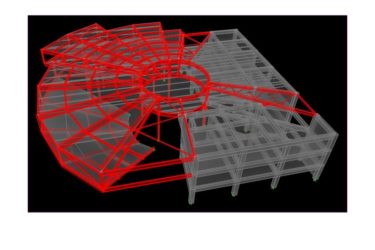
Image credit: Courtesy of PBL Lab
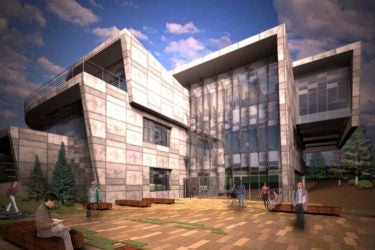
Image credit: Courtesy of PBL Lab
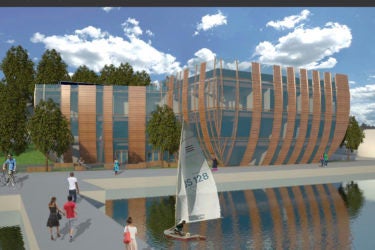
Image credit: Courtesy of PBL Lab
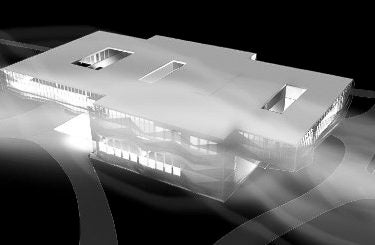
Image credit: Courtesy of PBL Lab
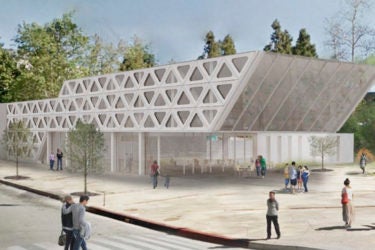
Image credit: Courtesy of PBL Lab
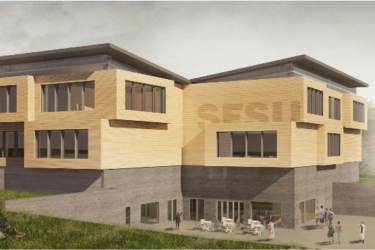
Image credit: Courtesy of PBL Lab
Working with a global team
AEC launches each year in January with every student coming to Stanford for a team-building workshop where they meet each other, mentors and the alumni who will play the part of building owners. While snacking on sandwiches made by Fruchter herself, they learn about the industry-sponsored challenges in which they’ll participate. After three days of fun, exciting, whirlwind team-building, they head back to their respective institutions and get to work. They don’t see each other again in person for four months.

Manuel Castellanos and Julianne Crawford discussing their team’s mid-year Fishbowl critique while the Atlantic team receives feedback from mentors. (Image credit: L.A. Cicero)

The mentors Nick Arenson, left, and David Bendet work with Aleshia Ayers MS ’17 at the SMART board during the class’s mid-year Fishbowl critique. (Image credit: L.A. Cicero)
In the intervening time, the students interact with and learn from some of the over 80 AEC owners, mentors and coaches who offer their time and expertise. The students also communicate with their teammates nearly every day, across several time zones.
“There were people working on a project literally all hours of the day,” said Mary Haywood, a second-year master’s student in sustainable design and construction (SDC) in the Civil and Environmental Engineering Department at Stanford. “If you hadn’t looked at your messages in an hour or two, you had to read all the things that happened while you weren’t paying attention. It’s like you had a full-time group relationship.”
During her first year as a master’s student, Haywood was part of the Pacific 2017 team, which designed a building for a site by Lake Merced at San Francisco State University. She was one of the team’s architects and had to work closely with the other architect, Bianka Swinder from Warsaw University of Technology.
The teams have no leaders and every member is expected to contribute equally. Their designs must take into account the desires and expertise of every discipline and lay out not only the building plans but also the schedule for and cost of construction, how they will account for the safety of their construction crew and how the building will stand up to natural elements and age in a sustainable fashion.
“This class really teaches you to think of all the disciplines and not just be in a silo of your own discipline,” said Julianne Crawford, who was one of the Pacific 2017 structural engineers and is now a second-year master’s student in SDC. “I really don’t think that any one person could’ve accomplished what all of us did.”
In addition to the challenges inherent to this profound level of teamwork, the teams also have sustainability and team process themes that they must address in their designs. This year, they had to make buildings that were responsive to occupants. For most of the teams, that resulted in also creating mock-ups of apps that would allow building occupants to reserve rooms, learn about events happening in the building and set environmental preferences such as lighting and temperature.
Presentations to industry, mentors, judges
At the end of winter quarter, the teams present four design options to the owners and mentors and decide which one to take further into project development. The teams then take the chosen alternative into the Fishbowl critique, an interactive problem-solving session designed by Fruchter through AEC and PBL Lab which is currently used in remote building design and construction work around the world. During the Fishbowl, each team presents a brief status update of their projects along with current design and construction challenges. After each presentation, industry mentors tackle the challenges using collaborative problem-solving practices while other teams observe.
Odelson still remembers when, in his Fishbowl session, a structural engineering professor acting as a mentor said he “couldn’t be dragged into our building with a dozen horses.” The team’s building was positioned on a cliff and the mentor was concerned it wouldn’t be sufficiently anchored into the hillside, Odelson explained. This Fishbowl led Odelson’s team to develop six additional design iterations, resulting in a final proposal that was praised by both Fruchter and that mentor.
For the final presentations from the 2016-2017 class, teams reunited in the Center for Integrated Facility Engineering (CIFE) iRoom at the end of spring quarter. Always intent on “leveraging technology as a transformative driver of project-based learning,” Fruchter pushed the students to figure out the best way to digitally unfold their designs across the iRoom’s six SMART boards. The Express team members, with a building located at the University of Ljubljana in Slovenia, chose to turn off some of their SMART boards when they wanted to draw attention to a particular slide. For their turn, the Pacific team members saved one screen for an animated tally that tracked how many days they shaved off a traditional construction schedule by emphasizing high efficiency in every decision.
Critiques and questions from the mentors followed each presentation. This year, an alumnus who is now on the faculty at Bauhaus–Universität Weimar said that the River team’s concept was the best created for that building site in five years, which was high praise given that the concept exists at his current institution and that he had designed for that same site when he was in AEC. Another mentor called the Atlantic team presentation – assigned to the University of Wisconsin-Madison campus and given in the form of a play – the “most unique” he had ever seen. The Pacific team received especially glowing reviews for its professionalism and one mentor recommended the team go into business together immediately.
“I felt an immense sense of joy rise inside of me,” said Manuel Castellanos Cantú, who was also on the Pacific 2017 team and is now a second-year master’s student in structural engineering at Stanford. “All the work we’d done throughout the two quarters paid off. There was just a lot of happiness.”
The Pacific team ended up winning both the Swinerton-AR Greendesign Consulting Sustainability Challenge and the DPR Challenge this year, both of which focused on creating buildings responsive to human occupation.
With their projects all resounding successes, these students are now part of a growing PBL Lab global learning community. This group has grown so large that some members have collaborated in the real world, such as when Erik Kneer MS ‘05, a structural engineer from Stanford, and Pete Dering, a construction manager from University of Wisconsin-Madison, were unintentionally paired together for a project in Berkeley years after being teammates in the AEC class. After becoming faculty at University of Puerto Rico, Cavallin worked with Fruchter to include some of his students from Puerto Rico in the AEC program.
“After you’re done with the class, you feel like you belong to PBL and not only are you grateful to Fruchter, you are happy to keep in touch with her,” said Cavallin. “Thanks to her, it’s like coming back home every year.”
To view past AEC global student team projects please visit the PBL Lab project gallery website.
Interviews for the 2016-17 AEC Global Teamwork course are currently underway. If you are a Civil and Environmental Engineering student at Stanford, you can sign up for an interview with Renate Fruchter (sign-ups at Y2E2 Building, room 289).
